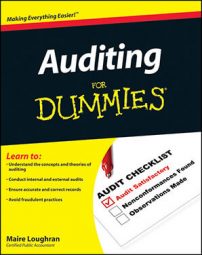Making sure your audit client is current with all areas of human resources-related compliance is one way to judge the competency of employees when you’re deciding whether to limit audit procedures. So what personnel records does a company need to keep? The basic forms a business must keep on file are as follows:
-
Job applications: Title VII of the Civil Rights Act of 1964 requires covered employers (basically those having more than 15 employees) to retain job applications for a period of one year from the date an application or disciplinary action was made. This is because Title VII makes it unlawful for an employer to hire, discharge, or discriminate against any individual because of race, color, religion, sex, or national origin.
-
Résumés for applicants and people hired: Title VII applies to resumes also. Both job applications and resumes would have to be provided by the company for any lawsuit filed under Title VII.
-
Benefit plan info: This info needs to be kept on file for one year after termination of the plan.
-
Family and Medical Leave Act (FMLA) certifications: FMLA certifications are in essence notes from the doctor attesting to the fact that the employee or a close family member has medical problems serious enough to qualify for leave.
-
*Payroll records: Payroll records retention became a contentious issue after passage of the Lilly Ledbetter Fair Pay Act of 2009. This act extends the time employees can pursue claims under antidiscrimination laws such as the Age Discrimination in Employment Act. As a result of this act, many of your clients will be archiving personnel records for indefinite periods to defend against any future discrimination suits.
-
Safety records: Depending on the type of business, your audit client may need to follow additional records retention guidelines. For example, chemical safety and toxic exposure records stay on file for the duration of someone’s employment plus 30 years after that employee leaves the company.
Your client is responsible for keeping many different payroll deduction and identification forms on file for each employee. These forms include those required by government and forms your audit client needs in order to make other non-tax-related payroll deductions. During your audit you may use these deduction forms to gauge the correctness of many different payroll transactions. You’ve more than likely filled out the following forms during your employment career:
-
W-4: This form gives the employer all the basics about an employee, such as name, address, and Social Security number. It also asks for marital status and number of exemptions, which dictate how much federal tax the employer is obligated to withhold from the employee’s check each pay period.
-
State and local tax withholding forms: If the company is required to withhold taxes for states and municipalities, these forms are kept as well.
-
I-9: The purpose of this form is to make sure employees are eligible for employment in the United States. The employee fills out the form and provides documentation that the employer copies and keeps in the personnel folder. Documentation includes picture IDs and paperwork attesting to the fact that the employee can work in the United States.
-
Discretionary benefit deduction forms: Employees use these forms to allow the company to deduct additional amounts from their gross wages to pay for such benefits as health insurance, pretax contributions to retirement plans, and union dues. These forms stay in-house as well.

